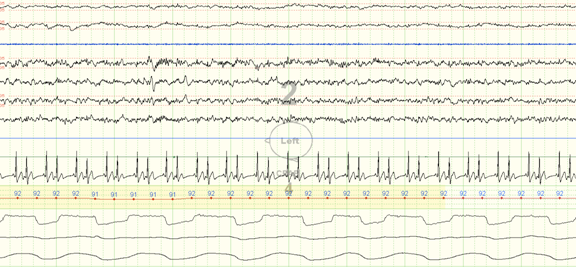Contributed by Kelly A. Carden, MD, MBA, Greg Bashian, MD and Atul Malhotra, MD
Discussion: The term “bigeminy” refers to a repeated pattern of pairs of complexes. Atrial bigeminy is an arrhythmia consisting of the repetitive sequence of one normal sinus impulse followed by one atrial premature complex. There is a constant interval between the normal beat and the subsequent premature beat. In addition, there is a constant interval between the premature beat and the subsequent normal beat.
Little is written about atrial bigeminy in the current cardiology textbooks and literature. Much of what we know is anecdotal in nature. Atrial bigeminy is an uncommon rhythm disorder as compared to ventricular bigeminy. The prevalence is not well known, but by all accounts, it is a rare finding in the general population. The premature beats usually arise from a single ectopic focus within the atria. The atrial focus is thought to become arrhythmogenic due to factors such as excess adrenaline, increased sympathetic stimuli, the use of caffeine, amphetamines, cocaine, and some medications, hyperthyroidism, and intermittent hypoxia. In this case, the patient was a 65 year old hypertensive patient with recently diagnosed obstructive sleep apnea who had returned to the sleep laboratory for a CPAP titration study. He had no other past medical history. Atrial bigeminy was also seen on his diagnostic study. The arrhythmia did not resolve with CPAP therapy despite excellent control of the patient’s sleep disordered breathing during the last two hours of the study.
Atrial bigeminy is usually a benign condition, though patients may complain of disturbing palpitations. The rhythm may rarely precipitate supraventricular tachycardias including atrial fibrillation and atrial flutter. Treatment includes correction of predisposing conditions/exposures, antiarrhythmic medications, and potentially electrophysiology study with radiofrequency ablation.
Note: CPAP PSG recorded using Nihon Kohden software.
References:
- Malhotra, A and Loscalzo, J, Sleep and Cardiovascular disease: an overview, Progress in Cardiovascular Diseases 2009, 51: 279-284.
- Monahan, K, Storfer-Isser, A, Mehra, R. et al, Triggering of nocturnal arrhythmias by sleep-disordered breathing events. J Am Coll Cardiol. 2009 ;54:1797-804.
- Caples, S, Gami, A, Somers, VK, Obstructive sleep apnea. Ann Intern Med. 2005 142:187-97
- Forclaz A, Derval N, Nault I, et al. Atrial bigeminy with recurrent supraventricular tachycardia. J Cardiovasc Electrophysiol. 2010; 21:1181-3




